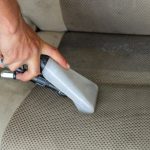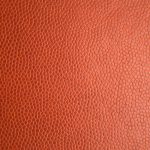Are you looking to create a unique and sustainable fabric? Look no further than apple leather!
In this article, we will guide you through the process of making your own apple leather fabric. You’ll learn how to source apple peelings, prepare and treat them, blend and press the apple blend, dry it, and finally, condition the apple leather.
So, grab your apron and let’s get started on this eco-friendly project!
Table of Contents
Sourcing Apple Peelings
Once you’ve gathered enough apple peelings, it’s time to start making apple leather fabric. When it comes to sourcing apple peelings, it’s important to find reliable suppliers who use sustainable methods. By choosing suppliers who prioritize sustainability, you can ensure that the apple peelings used in your fabric production are obtained in an environmentally friendly manner.
To find apple peelings suppliers, start by researching local apple orchards or farms in your area. Many orchards produce a large amount of apple waste, including peelings, which can be repurposed for leather fabric production. Contact these orchards and inquire about their apple peeling waste. Some may be willing to sell or even donate their peelings to your project.
In addition to local suppliers, you can also explore partnerships with food processing companies or juice manufacturers. These companies often have a surplus of apple peelings that they discard as waste. By collaborating with them, you can divert this waste from landfills and use it to create sustainable apple leather fabric.
Remember to prioritize suppliers who practice sustainable sourcing methods. This ensures that the apple peelings used in your fabric production are obtained without causing harm to the environment. By sourcing apple peelings responsibly, you can contribute to a more sustainable and eco-friendly approach to fabric production.
Preparing the Apple Peelings
After you’ve gathered all the necessary ingredients, start by washing and peeling the apples. This step is essential to ensure that your apple leather fabric is clean and free from any dirt or pesticides.
When sourcing apple waste, it’s important to choose apples that are organic and free from any chemicals. Washing the apples thoroughly under running water will help remove any surface dirt or residue.
Once washed, use a vegetable peeler to remove the outer skin of the apples. This step is crucial as the skin contains pectin, a natural substance that helps bind the apple leather fabric together. By peeling the apples, you are also reducing the environmental impact as the peels can be repurposed into leather-like material instead of being discarded as waste.
Make sure to discard the peels in a compost bin or find other creative ways to use them. Once the apples are washed and peeled, you can proceed to the next step of making your apple leather fabric.
Treating the Apple Peelings
To treat the apple peelings, you’ll need to soak them in a mixture of water and vinegar for about 10 minutes. This will help remove any dirt or residue from the peels and make them easier to work with for your apple peeling crafts.
Here are four simple steps to treat your apple peelings:
- Gather your apple peels and place them in a bowl.
- Fill the bowl with enough water to cover the peels.
- Add a splash of vinegar to the water. The vinegar will help break down any remaining dirt or pesticides on the peels.
- Let the peels soak in the water and vinegar mixture for about 10 minutes. This will give the mixture enough time to do its job and ensure that your apple peelings are clean and ready to use.
Once you’ve treated your apple peelings, you can use them for a variety of crafts, such as making apple leather fabric. Alternatively, if you’re not interested in crafts, you can compost the peelings to create nutrient-rich soil for your garden.
Blending the Apple Peelings
First, grab your blender and toss in the treated apple peelings. Blending apple peelings has several benefits, both for your health and the environment.
When you blend the peelings, you release their natural fibers and nutrients, which can be easily consumed by your body. These nutrients include vitamins A and C, as well as dietary fiber. By incorporating apple peelings into your diet, you can improve digestion, boost your immune system, and promote healthy skin.
But the benefits of blending apple peelings don’t stop there. You can also use the blended peelings for composting. When you add them to your compost pile, they provide valuable organic matter that enriches the soil. The peelings break down quickly, adding nutrients back into the earth and improving soil structure. Composting apple peelings reduces waste and helps create a sustainable gardening practice.
Pressing the Apple Blend
Once you’ve blended the apple peelings, you can now press the mixture to extract the juice. Pressing the apple blend is an important step in the process of making apple leather fabric. Here’s how you can do it:
-
Get a clean piece of cloth or cheesecloth. Place it over a container or bowl.
-
Pour the blended apple peelings onto the cloth. Make sure to spread it evenly.
-
Gather the edges of the cloth and twist it tightly to form a bundle. Squeeze the bundle to extract as much juice as possible. This juice can be used for other purposes, such as making apple cider or adding flavor to recipes.
-
Once you’ve extracted the juice, carefully unfold the cloth and transfer the remaining apple pulp onto a baking sheet lined with parchment paper. Spread it evenly to achieve a uniform thickness.
Pressing the apple blend helps to remove excess moisture and further concentrate the flavor. It also helps in binding the fibers together to create a cohesive fabric-like material.
By using apple leather alternatives, you can reduce the environmental impact of traditional leather production, as apple leather is biodegradable and cruelty-free.
Drying the Apple Leather
When it comes to drying your apple leather, there are a few key points to consider.
First, you’ll want to explore the optimal drying methods to ensure the best results.
Second, understanding the time required for drying will help you plan accordingly.
Lastly, it’s important to take steps to prevent mold or damage during the drying process.
Optimal Drying Methods
For the best results, you’ll want to use a food dehydrator or an oven to dry the apple puree into leather fabric. These methods ensure that the apple puree is evenly dried, resulting in a flexible and chewy texture. Here are some tips to optimize the drying process:
-
Set the temperature: The optimal temperature for drying apple leather is around 140°F (60°C). This temperature allows the moisture to evaporate without overheating the puree.
-
Ensure proper air circulation: Good air circulation is essential to remove moisture from the puree. If using a food dehydrator, make sure the trays are evenly spaced, allowing air to flow freely. If using an oven, leave the door slightly ajar to allow air to circulate.
-
Rotate the trays: To ensure even drying, rotate the trays halfway through the drying process. This helps prevent any parts of the puree from drying faster than others.
-
Check for doneness: Apple leather should be dry to the touch and easily peel off the tray. It should not be sticky or tacky. If needed, continue drying until you achieve the desired consistency.
Time Required for Drying
To achieve the desired consistency of the dried apple puree, you’ll need to make sure it is left to dry for a sufficient amount of time.
The drying time for apple leather can vary depending on the drying technique used and the moisture content of the puree. Generally, it takes anywhere from 6 to 12 hours to dry the apple puree in a food dehydrator set at 135°F (57°C). If you’re using an oven, it may take slightly longer, around 8 to 14 hours at the lowest temperature setting.
It’s essential to monitor the drying process regularly and check for a leathery texture before removing the apple puree. Remember, the drying time may vary, so it’s vital to follow the specific instructions provided by your chosen drying technique.
Preventing Mold or Damage?
Now that you’ve learned about the time required for drying apple leather fabric, let’s talk about how to prevent mold or damage and preserve its quality. Here are some important tips to keep in mind:
-
Proper storage: Store your apple leather fabric in a cool, dry place away from direct sunlight. Moisture and heat can promote mold growth and deterioration.
-
Air circulation: Ensure proper air circulation around your apple leather fabric by placing it in a breathable container or wrapping it loosely in a breathable fabric. This will help prevent moisture buildup and mold formation.
-
Regular inspection: Regularly inspect your apple leather fabric for any signs of mold or damage. If you notice any, take immediate action to prevent further spreading.
-
Cleanliness: Keep your work area, tools, and hands clean when handling apple leather fabric. This will minimize the risk of introducing mold or contaminants.
Conditioning the Apple Leather
To keep your apple leather fabric in good condition, it’s important to properly moisturize it.
Moisturizing the leather will prevent it from cracking and drying out, ensuring its longevity.
Choosing the right conditioner for your apple leather is crucial, as it will help maintain its softness and flexibility.
Moisturizing the Leather
Make sure you’re applying enough moisturizer to keep the leather fabric soft and supple. Moisturizing is an essential step in maintaining the quality and longevity of your leather items. Here are four moisturizing techniques and the benefits they provide:
-
Use a leather conditioner: Applying a leather conditioner helps to replenish the natural oils in the leather, preventing it from drying out and cracking.
-
Apply a leather moisturizing cream: Moisturizing creams are specifically designed to penetrate deep into the leather, nourishing it and keeping it hydrated.
-
Use a leather balm: Leather balms not only moisturize the leather but also provide a protective layer, shielding it from dirt, stains, and moisture.
-
Regularly wipe down with a damp cloth: Simply wiping down your leather items with a damp cloth helps to remove dirt and dust while adding a small amount of moisture to the leather.
Preventing Cracking and Drying
Ensure you’re applying enough moisturizer to prevent cracking and drying of your leather items. Cracking and drying are common issues that leather can face if not properly cared for.
To prevent cracking, it is important to keep your leather items moisturized. Apply a leather conditioner or moisturizer regularly, ensuring that you cover all areas of the leather. This will help to maintain the suppleness of the leather and prevent it from becoming stiff and brittle.
Additionally, avoid exposing your leather items to extreme temperatures or direct sunlight, as this can also contribute to cracking and drying.
Choosing the Right Conditioner
Now that you know how to prevent cracking and drying of your leather, let’s talk about the importance of choosing the right conditioner. Using a conditioner is essential to keep your leather soft, supple, and in good condition.
Here are some benefits of using the right conditioner:
-
Moisturizes and nourishes: A good conditioner replenishes the natural oils in the leather, preventing it from drying out and cracking.
-
Restores and rejuvenates: The right conditioner can revive worn-out leather, restoring its color and luster.
-
Protects against stains and damage: Conditioning forms a protective barrier on the surface of the leather, guarding it against spills, stains, and everyday wear and tear.
-
Prolongs the lifespan: Regular conditioning helps to maintain the integrity of the leather, extending its lifespan and keeping it looking great for years to come.
To ensure you get the most out of your conditioner, here are some common mistakes to avoid:
- Using the wrong type of conditioner for your leather.
- Applying too much conditioner, which can lead to greasy or sticky leather.
- Not following the manufacturer’s instructions.
- Neglecting to condition your leather regularly.
Using the Apple Leather Fabric
To start using the apple leather fabric, you’ll want to carefully cut it into your desired shape and size.
Apple leather has become increasingly popular in the world of fashion due to its eco-friendly nature and sustainability benefits. Made from apple waste, it offers a cruelty-free alternative to traditional leather. By using apple leather, you are helping to reduce the demand for animal leather, which contributes to deforestation and greenhouse gas emissions. Additionally, apple leather is biodegradable, meaning it can break down naturally without harming the environment.
When incorporating apple leather into your fashion designs, you’ll find that it is versatile and can be used to create a wide range of products, such as bags, shoes, and accessories. Its durability and flexibility make it suitable for various applications, and it can be dyed or embossed to achieve different textures and colors.
Another benefit of apple leather is that it requires less water and energy to produce compared to traditional leather. The production process involves recycling apple waste, which would otherwise be discarded, reducing waste and promoting a circular economy. By choosing apple leather, you are making a conscious choice towards a more sustainable and ethical fashion industry.
Conclusion
So there you have it, a simple and eco-friendly way to make apple leather fabric.
By sourcing apple peelings, treating and blending them, pressing and drying the blend, and finally conditioning the leather, you can create a beautiful and sustainable material.
Whether you want to use it for clothing, accessories, or even upholstery, apple leather fabric is a versatile option that is sure to impress.
So why not give it a try and join the movement towards more sustainable fashion choices?
- Kevlar Woven Fabric: Black and Color Options - June 21, 2025
- Kevlar Wool Fabric: Blending Comfort With Protection - June 21, 2025
- Kevlar Vs Carbon Fiber: Pros and Cons for Composites - June 21, 2025





